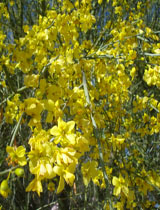 The willow acacia is a desirable decorative tree for many homeowners in Arizona, but this year's extremely cold temperatures tested many of these usually hardy plants to the limits.
The willow acacia is a desirable decorative tree for many homeowners in Arizona, but this year's extremely cold temperatures tested many of these usually hardy plants to the limits.
Since the Trees for Tucson program was established in 1989, residents in Southern Arizona have planted tens of thousands of trees in our community. But when a record-breaking frost struck Tucson in February, many specimens of one popular tree--the willow acacia--were not able to handle the climatic challenge.
Rani Olson is the program's coordinator and she says her telephone has been ringing consistently, beset by people who don't know what to do with their willow acacias. The tree is a desirable, evergreen, thornless plant from Australia that has been planted heavily in Arizona's Sonoran desert.
The trees aren't suited to the cold, so many were heavily damaged or even destroyed by this winter's lows.
 Many local residents are calling the Trees for Tucson program about willow acacias that were damaged or killed by February's cold temperatures.
Many local residents are calling the Trees for Tucson program about willow acacias that were damaged or killed by February's cold temperatures.
Olson says it's somewhat ironic, because people in the Sonoran desert usually pick plants for the predictable dry and hot extremes. The deep freeze added a new band to the spectrum of conditions desert residents expect.
But Trees for Tucson--which is part of Tucson Clean and Beautiful--had already discontinued providing the willow acacias for another reason, and the weather wasn't it.
Due to the tough economy, many people are trying to save money or are losing their homes, which means they haven't been able to give the willow acacias the water and care they need for optimum growing conditions. Those trees had already been struggling and the cold weather added insult to injury.
 Experts recommend native trees, such as the palo verde, which are better at handling our region's extreme weather.
Experts recommend native trees, such as the palo verde, which are better at handling our region's extreme weather.
So Trees for Tucson is concentrating on native trees now, such as palo verde, white thorn acacia, desert willow and sweet acacia. Olson says even the popular Chilean mesquite, another non-native like the willow acacia, will also be discontinued.
And while the cold and the economy may have made it more challenging to grow some trees, Olson hopes that residents continue to dig in and liven up their gardens and neighborhoods. Trees provide multiple benefits, including shade, habitat for wildlife and beauty.
Trees for Tucson offers trees for $8 to customers of Tucson Electric Power Company who qualify for the program.

By submitting your comments, you hereby give AZPM the right to post your comments and potentially use them in any other form of media operated by this institution.